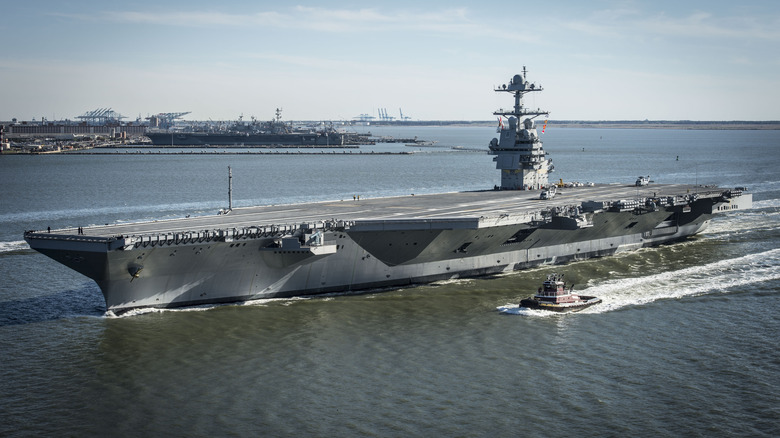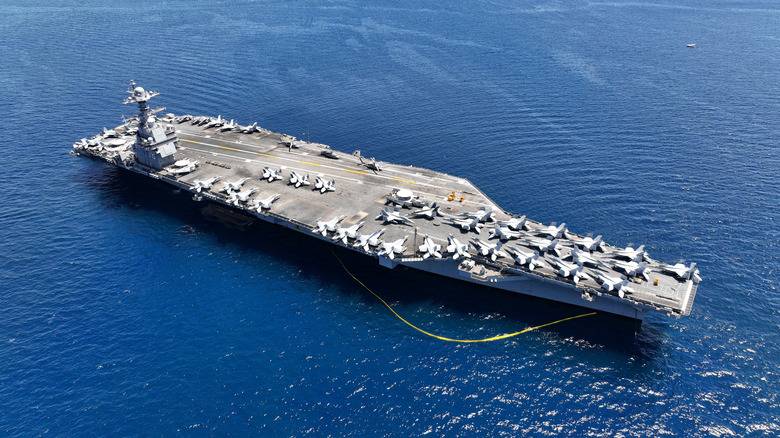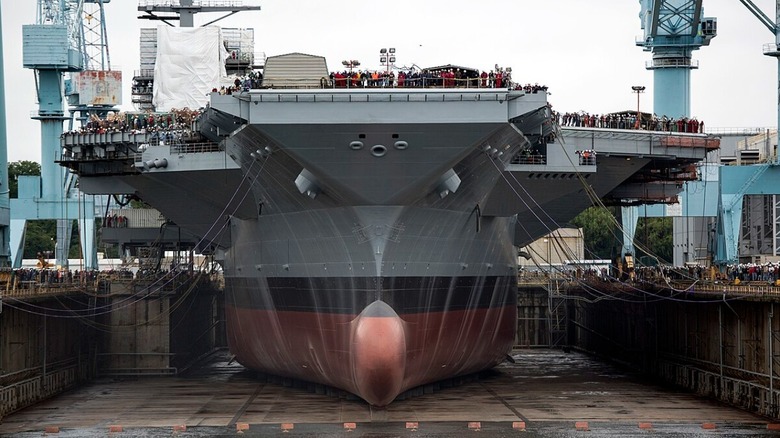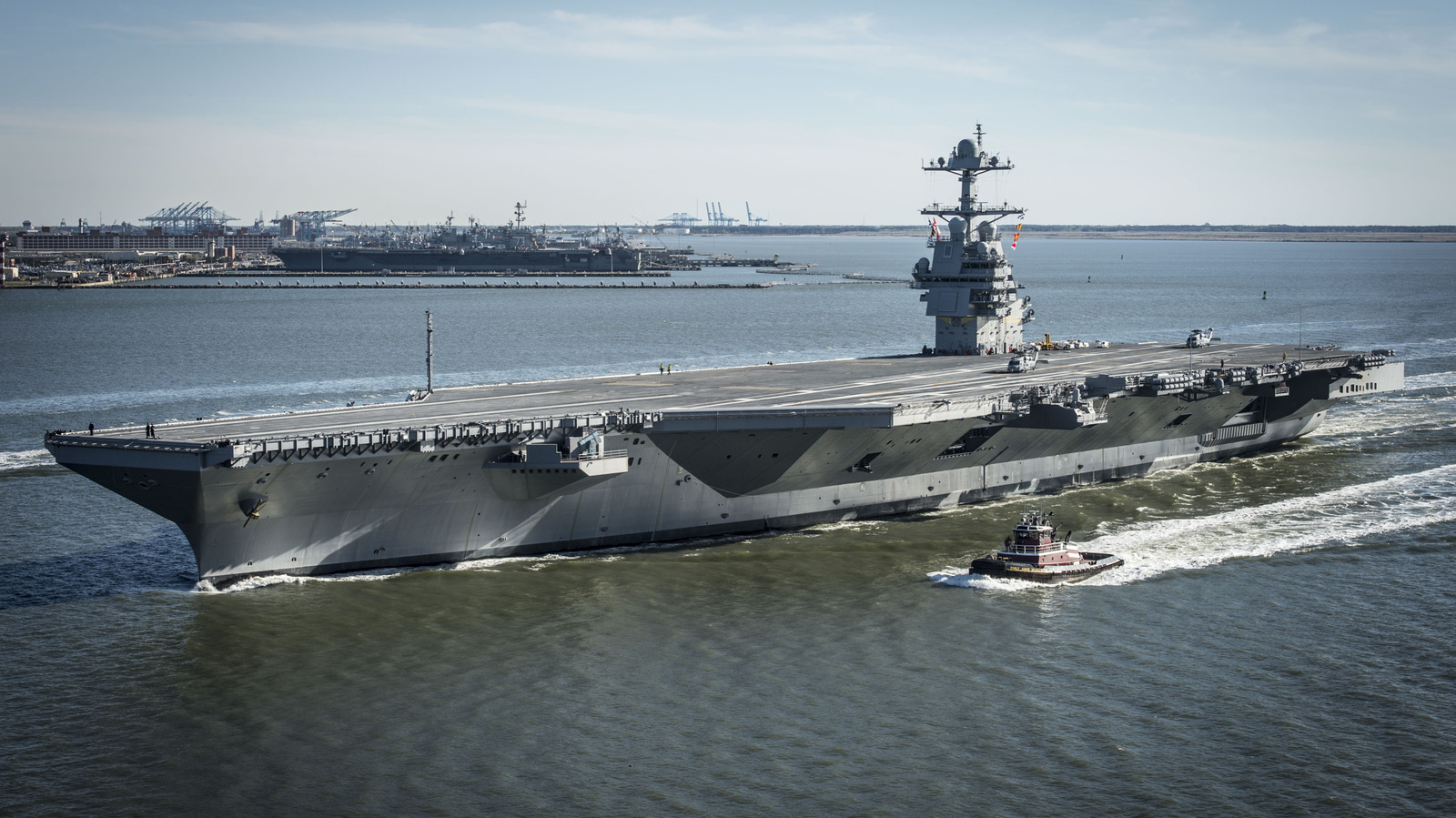 U.s. Navy/Getty Images
U.s. Navy/Getty Images
An aircraft carrier is an enormous and imposing vessel. They also represent gigantic investments in terms of not only money but in development time and other resources. The last thing a nation would want is for such a critical asset to be lost. An aircraft carrier is equipped with its own potent guns and defenses and often chaperoned by other naval powerhouses to help defend it. The sea, however, is a mighty adversary, and it doesn't matter to a harsh storm how big and well-armed a vessel and its allies might be. In the worst of conditions, such as a devastating hurricane, it's not uncommon to see naval vessels go out to sea. It's a defensive technique that can help such vessels better manage conditions. Aircraft carriers, in particular, are extremely unlikely to be flipped over or capsized even in the harshest seas. This is mostly thanks to their unique design.
Weather conditions and gravity have had tremendous influences on sailors' experiences for centuries, potentially tossing a ship from side to side and defying even the most experienced navigators. The critical thing for a carrier, though, is that it is created so that it has a low center of gravity. Similarly to a cruise ship, this helps to ensure stability on ever-moving seas, though aircraft carriers may not have the luxury of planning the calmest routes to destinations or being able to move on regularly. The center of its buoyancy is higher than this point, and combined with the flatness of a lot of a carrier's design, this means that the vessel as a whole is designed to essentially be self-righting. Let's take a closer look at the design of an aircraft carrier and how it lends itself to this.
How the unique shape of an aircraft carrier helps to keep it afloat
 Aerial-motion/Shutterstock
Aerial-motion/Shutterstock
Like a cargo ship, the primary goal is to ensure as much deck/storage space as possible. Beyond that, though, there's far more to consider. Cargo ships, often needing to secure shipping containers, have a range of their own designs and special features to keep their payloads as safe as possible on a journey, such as clamps and allocated areas for the stowing of cargo. With an aircraft carrier, it's not just about providing space for aircraft to land, refuel and be resupplied, and takeoff again. They have to be secure in doing so at all times. As such, every aspect of a carrier helps to keep the overall structure balanced.
The key, as is so often the case with balance, is weight distribution. Just as a set of scales will inevitably tip to one side if it bears more weight than the other, these forces will act on a ship in the same way. In nautical terms, a lean to port or starboard is called a list, and the more pronounced it is, the more danger a ship could potentially be in. It's inevitable that a ship won't be perfectly flat on the water for a whole journey, and so a huge priority of the designing and manufacturing of aircraft carriers is ensuring that they have the capacity to resist these forces as efficiently and quickly as possible. The low center of gravity of the ship means that the beginnings of a tip will cause it to be lifted out of the ocean, and so the pressure needed for it to continue tipping increases.
The very shape of the vessel itself
 Wikimedia Commons / U.S. Navy photo by Mass Communication Specialist 1st Class Joshua J. Wahl, resized and cropped, Public Domain.
Wikimedia Commons / U.S. Navy photo by Mass Communication Specialist 1st Class Joshua J. Wahl, resized and cropped, Public Domain.
In the design of san aircraft carrier, nothing can be taken for granted. There's a tapering aspect to an aircraft carrier such as the U.S.S. Gerald R. Ford, the largest carrier ever built; it's a lot wider than you'd expect underneath the surface. In addition, the bow of the ship is rounded, and this allows it to limit the effect of drag from water gathering there over more traditional sharper prows. An aircraft carrier, then, is rather like an iceberg, in that appearances from above the surface of the water can be very deceptive. The special shape of an aircraft carrier makes it not only much safer and more balanced in the water than you might think, but perhaps considerably quicker too. In fact, the aircraft carriers of the U.S.S. Gerald R. Ford class have top speeds of over 30 knots.
Carriers are huge and powerful vessels, and their primary role is as a runway for aircraft. Unfortunately, accidents do happen on aircraft carriers, and some military aircraft have been lost overboard. It's thanks to the inherent steadiness of a carrier, though, that these pricey losses aren't far more common. Counterbalance systems and the positioning of ballast are also means through which those aboard an aircraft carrier can adjust weight distribution on these mighty ships.




